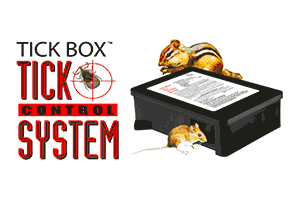Home
Risk
Vectors
Disease
Sense
Impact
How
Install
Q & A

Take back your yard from ticks and tick-borne diseases.
Take back your yard from ticks and tick-borne diseases.
Introducing
Introducing
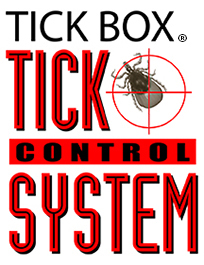
TICK BOX TICK CONTROL SYSTEM
IS AN ALTERNATE BRAND NAME OF SELECT TCS
CLICK HERE FOR THE PUBLISHED STUDY:
TICK BOX VS. TICK TUBE
© 2020 Tick Box Technology Corporation, Norwalk, CT
Tick-borne disease:
A serious and growing threat, right in your own yard.
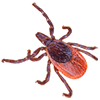
ick-borne disease is on the rise in the United States — Lyme Disease in
particular. If you live in the northeastern part of the country, you probably
know that. In fact, you probably know people who have had Lyme Disease.
You may have had it yourself. If so, you probably contracted it at home, because
in the northeastern United States, people are most likely to contract Lyme Disease
on their own property. Your odds of contracting the disease are directly related to
the number of ticks on your property that carry the disease-causing bacteria.
Lyme Disease is not an illness to be taken
lightly. It can be difficult to diagnose, and
if it goes undiagnosed and untreated, it
can result in serious, permanent damage to
the victim’s joints and heart. Animals can be
affected, too. Dogs, cats, and horses, are all
subject to Lyme Disease.
August 19th, 2013- CDC announces Lyme
disease infects 300,000 annually.
More than 300,000 cases of Lyme disease are reported to
the CDC every year, making it the most commonly reported
tick-borne illness in the United States, the CDC says. But some
reports have suggested it is far more common than that.
Areas of risk for
Lyme Disease transmission
High risk
Moderate risk
Low risk
Minimal or no risk
T
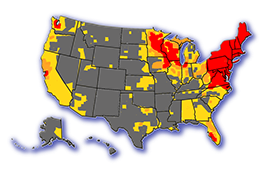

Lyme Disease is
now the most
commonly reported
vector-borne
illness in the
United States.
Source: CDC
Health officials
believe that over
of reported cases of
Lyme Disease are
contracted from a tick
found on a person’s
property.
Source: CT Department
of Agriculture
75%
© 2018 Tick Box Technology Corporation, Norwalk, CT
Ticks.
Most Notably The Deer Tick (Ixodes scapularis).


s most people know, the deer tick is the culprit that infects people and
animals with Lyme Disease. Naturally then, when most people think of
the disease, they think of deer and deer ticks.
Deer do serve as hosts to the deer tick, but they are
passive hosts. The most important players in the
spread of Lyme Disease is the white-footed mouse
and chipmunk. These rodents primarily harbor the
bacteria that cause Lyme Disease. Ticks pick
up the bacteria when they feed on the blood of infected animals.
While in the immature stages, deer ticks pass the Lyme
Disease bacteria to and from the mice and chipmunks they they typically feed on. During the tick's nymph stage,
they might also feed on humans and pets. At this point,
the ticks are light in color and no bigger than pinheads, so they’re hard to see and can easily go undetected.
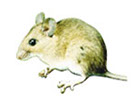
The risk of
Lyme Disease
is at its peak in
JULY
when deer ticks are in the nymph stage and people are often outdoors.
A

© 2018 Tick Box Technology Corporation, Norwalk, CT
Lyme Disease and the deer tick life cycle.
he chart below illustrates the deer tick’s life cycle and and how Lyme Disease is transmitted to humans. Note that in the chart, the deer ticks are shown actual size in each of their stages.
T

Deer tick ADULTS mainly feed on deer and other mammals. Because
the adult ticks are more easily seen, and since it takes 36 hours for the
disease to be transmitted, these ticks are usually detected before they
can spread the disease. Therefore, they do not pose as big a risk in
transmitting Lyme Disease as the nymphs do. After feeding, they drop
from the deer to lay their eggs.
Lyme Disease infected deer tick NYMPHS feed on humans and pets,
as well as rodents and deer. Because of their coloring and small size,
nymphs easily escape detection. This is the time when humans are
most likely to become infected with Lyme Disease.
Deer tick LARVAE primarily feed on rodents (mainly the white-footed
mouse and chipmunk), other small mammals, and birds.
Infected rodents pass Lyme Disease to the deer tick LARVAE. On
average, 25% of ticks are infected, most having contracted
the disease from the white-footed mouse or chipmunk.
Disease-free deer tick EGGS hatch and develop into LARVAE.
Deer Tick Activity and How Lyme Disease is Transmitted to Humans
Y
E
A
R
O
N
E
Egg
Larva
Nymph
Adult
Stage
Season
Spring
Summer
Fall
Winter
Spring
Summer
Fall
Winter
Y
E
A
R
T
W
O
From left to right, the larva, nymph, male adult, female adult and replete female deer ticks shown measured against a ruler. The photo has been enlarged 400% to show detail.
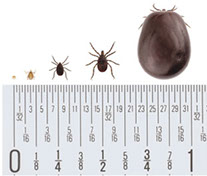
Each female deer
tick lays up to
approximately
3,000
eggs each Spring.
© 2018 Tick Box Technology Corporation, Norwalk, CT

The Tick Box Tick Control System makes sense.
here are measures you can take to reduce the risk of Lyme Disease
on your property. Basically, these involve making your landscape
less attractive to mice and deer and less hospitable to ticks:
* Keep piles of firewood and bird feeders away from your home.
* Remove leaf litter as much as possible.
* Trim trees and bushes to allow more light to enter shady landscapes.
And, when locating children’s playsets, choose areas that are sunny where the
grass can be kept short. Keep in mind,though, that these measures are not going to rid your property of mice, and a single mouse might well be carrying more than 100 deer ticks. Attempting to control the outdoor population of mice is futile, but you can control the ticks. There is, in fact, an easy-to-use, low-maintenance, highly effective means of ridding your yard of ticks and reducing your chances of contracting Lyme Disease . The Tick Box Tick Control System interrupts the Lyme Disease cycle without harming wildlife, damaging the environment, or threatening the health of your family with high-dose pesticides.
T
© 2018 Tick Box Technology Corporation, Norwalk, CT
The Tick Box Tick Control System makes a difference.
eveloped by the Centers for Disease Control (CDC) and Prevention
with commercial application development consultants from the
Connecticut Tick Control Company, the Tick Box Tick Control System has been proven effective in significantly reducing the number of ticks present in the landscape. In field trials, the Tick Box Tick Control System reduced tick populations by as much as 88%* after just one year, as the chart below illustrates. The rate of infection in ticks that remain in the landscape also decreases: While 25% of nymph ticks present commonly carry the disease, the System reduces the percentage of infected ticks to just 7% of the total population after the first year. Both the total number of ticks and the Lyme Disease infection rate in the ticks present continue to decrease during the second year of treatment. Most impressive, the total number of ticks present in the landscape was reduced by 97.3% by the end of the second year of treatment, based on field trials.
D
Reduces tick
populations by
nearly after 88%*
just one year.
Source:
CDC data
Monmouth County,
New Jersey 2015

“Due to the high incidence
of ticks in our yard, we thought
it was risky to let our children play
outside. After using the Tick Box Tick Control System, it’s rare to see a tick in our yard.”
Homeowner, Mason’s Island, CT
100%
80%
60%
40%
20%
TOTAL NYMPH POPULATION
INFECTED POPULATION
0%
UNTREATED
AFTER 1 YR
AFTER 2 YRS
As an example, a square yard of grass shelters 100 ticks before the Tick Box Tick Control System is installed. A quarter of them (25) carry the bacteria for Lyme Disease. After the System has been in place for a year, the nymph population will have been reduced to 21, and only 2 ticks (or 7%) will carry the Lyme Disease bacteria. At the end of the second year of treatment,only 4 tick nymphs will be present in the square yard of grass,and it will be difficult to find any that still carry Lyme Disease.
NYMPH POPULATION
The Tick Box Tick Control System
Reduces Ticks and Lyme Disease.
© 2018 Tick Box Technology Corporation, Norwalk, CT
How the Tick Box Tick Control System works.
they will receive additional protection. Keep in mind that
the system boxes are self-contained, and the
insecticide they use is not a threat to any animal other
than ticks on small rodents. The system is effective for
approximately 90 days as installed, with two 90-day installations that take care of ticks for a full season.

he key to the Tick Box Tick Control System is a small, plastic box which
holds an insecticide that’s effective against ticks, and a bait that’s attractive to
mice. Your pest management professional or lawn care operator determines
how many boxes you need to protect your property and places them in the interface
between landscaped and wooded areas.
The bait will attract mice living on and
around your property to the system boxes.
As a mouse moves through a box, it will pass
under a small applicator wick containing a
low-dose insecticide. The wick will lightly brush
its head or shoulders, gently applying traces of
the insecticide. The insecticide won’t harm the mice or any other animal that might touch or even eat them, but it will kill the ticks that the mice are carrying. A single dose will protect mice for up to 40 days against any new ticks. As they return to the system,
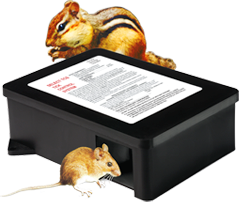
T

© 2018 Tick Box Technology Corporation, Norwalk, CT
his Illustration shows a typical installation of
the Tick Box Tick Control System. Your
authorized applicator determines how many boxes you need to protect your property and installs them in the "tick zone" (the interface between landscaping and the woods where ticks and rodents are abundant). The shaded areas illustrate the typical rodent territory in your yard.
Ticks do not travel more than a few feet on their own, so by treating the rodents that have developed territories around your property, you can have a dramatic effect on reducing the tick population that is present each season.
T
A Typical System Installation

It’s Fipronil, one of the
world’s best insecticides,
and the choice of the CDC.
he insecticide used in the
Tick Box Tick Control
System is Fipronil, an extremely low-dose insecticide with an amazing track record for performance. Fipronil is the active ingredient in the popular flea and tick treatment veterinarians commonly prescribe for household pets. And, it is used around the world in a variety of products designed to protect crops from destructive insects. Just a trace amount of Fipronil applied on a mouse is sufficient to kill ticks for days, yet it will not harm the mouse or any other animal it contacts. The Centers for Disease Control and Prevention tested several chemical compounds before deciding on Fipronil for the Tick Box Tick Control System. Fipronil’s winning characteristics included extremely high efficacy and long residual.
T

© 2018 Tick Box Technology Corporation, Norwalk, CT
Secure your property with Tick Box.
Keep in mind that the Tick Box Tick Control System is available only through a select number of professionals who have been specially trained and certified to offer it.
To put the System to work in your yard, look for an authorized installer in your area.
"I have deer on my property, some of my neighbors have Lyme disease, and i have a young child, so i had the Tick Box Tick Control System installed. It totally wiped out the tick population.
I feel safe when my child goes out now."
Ron Contino
Wilton, CT

TICK BOX TICK CONTROL SYSTEM
IS AN ALTERNATE BRAND NAME OF SELECT TCS
A product of
Tick Box Technology Corporation

What if my cat eats mice that
have been in contact with the
System?
It takes very little insecticide to
control ticks on a small rodent,
and the insecticide used in the Tick Box Tick Control System is an extremely low-dose insecticide. Studies showed that a cat would have to eat approximately 600,000 mice in a day’s time to suffer any ill effects.
Why not kill the rodent hosts?
Eliminating the hosts is not practical. During a study in Duchess County, New York, all rodents were removed from a one-acre plot,but it was an enormous task. And, after the study was concluded,the rodent population rebounded within two months.
What about all the other rodents present, squirrels, etc?
The white-footed mouse is by far the most important host for the Lyme Disease bacterium. The eastern chipmunk is a secondary host,and the meadow vole may also be a factor. These animals can be handled by the System. Squirrels are too large, but they don’t appear to play a significant role in Lyme Disease risk for humans.
Do deer carry the disease, too?
While deer are not carriers of the disease, they are involved in its spread. They range over very large areas and can deposit in your lawn deer ticks that they picked up elsewhere. Where deer populations are high, so are deer tick numbers and the possibility of tick and deer mouse interactions. Deer fencing and localized deer reduction programs will help to reduce the risk of Lyme Disease.
How much will the System cost?
The price will vary depending on your property and the number of boxes needed. A Tick Box Certified installer will need to do an estimate for you; however, consider the service as being comparable to a thorough pesticide application.
Questions & Answers
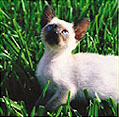
© 2018 Tick Box Technology Corporation, Norwalk, CT
* Schulze, T.L., R.A. Jordan, M. Williams, and M.C. Dolan. 2017. Evaluation of SELECT Tick Control System (TCS), a host-targeted bait box, to reduce exposure to Ixodes scapularis (Acari: Ixodidae) in a Lyme disease endemic area of New Jersey J. Med. Entomol. 54: 1019-1024

